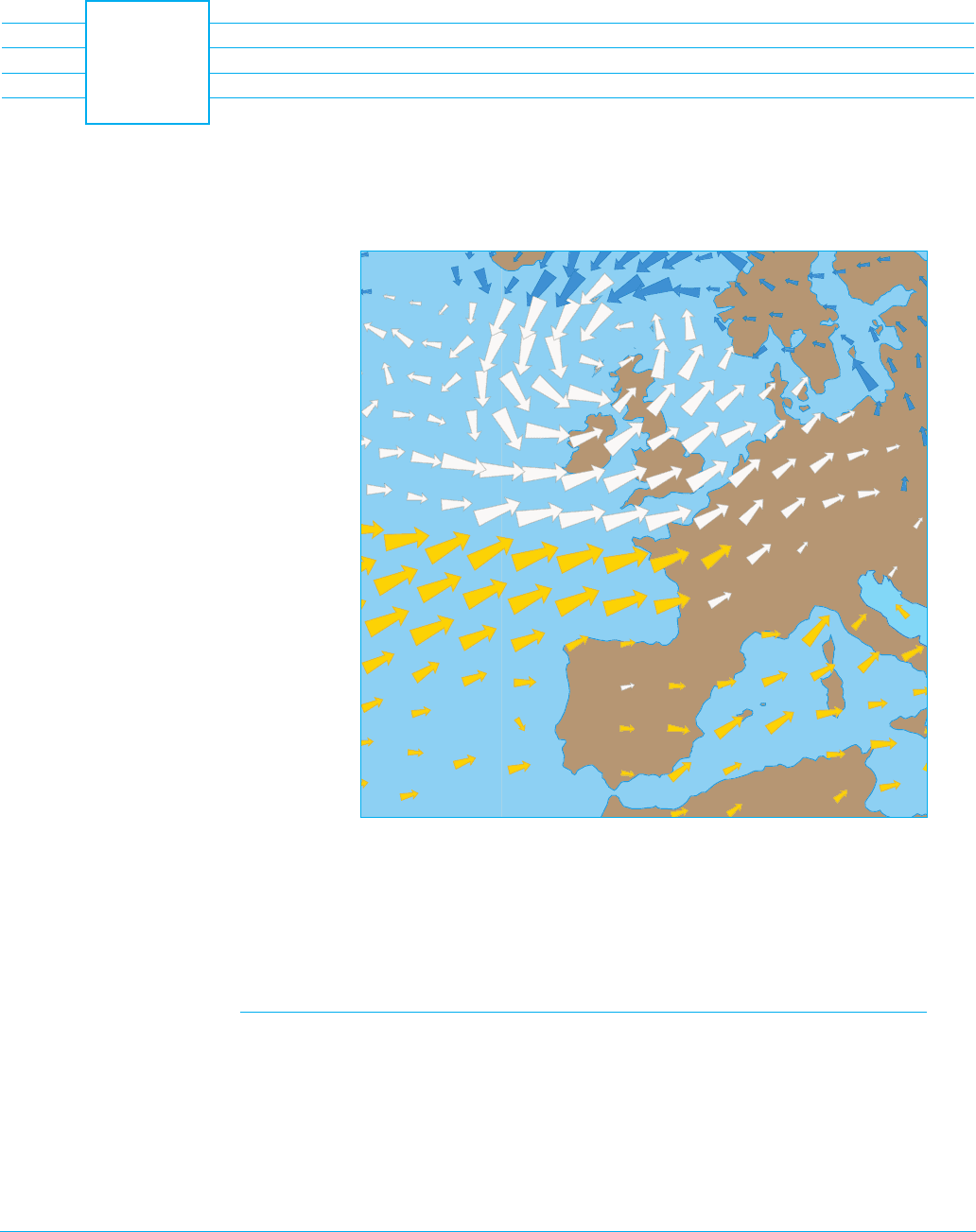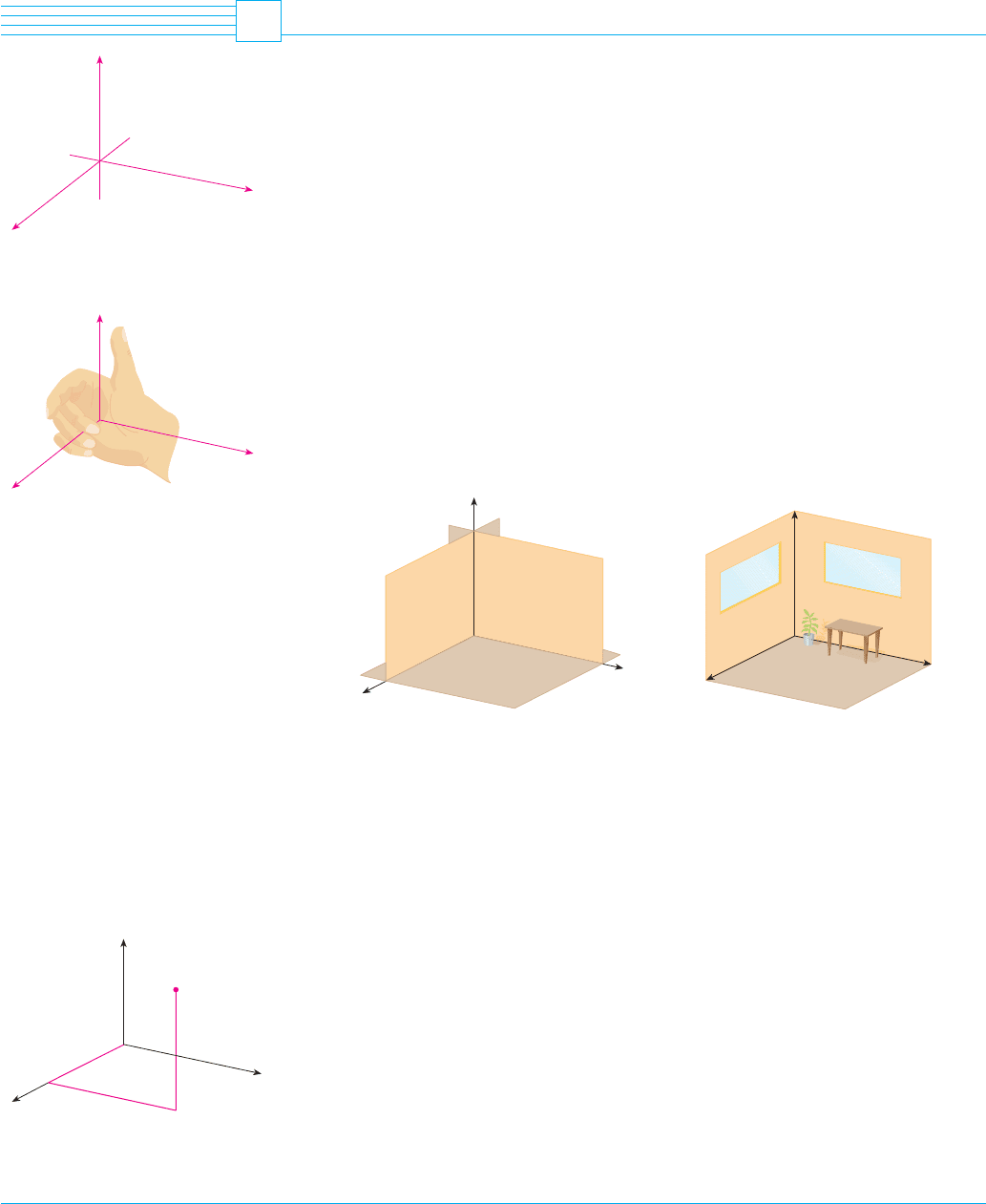Stewart J. Calculus
Подождите немного. Документ загружается.


792
|| ||
CHAPTER 12 INFINITE SEQUENCES AND SERIES
Equation 4 for third-order optics. [Hint: Use the first two
terms in the binomial series for and . Also, use
.]
35. If a water wave with length moves with velocity across a
body of water with depth , as in the figure, then
(a) If the water is deep, show that .
(b) If the water is shallow, use the Maclaurin series for
to show that . (Thus in shallow water the veloc-
ity of a wave tends to be independent of the length of the
wave.)
(c) Use the Alternating Series Estimation Theorem to show
that if , then the estimate is accurate to
within .
36. The period of a pendulum with length that makes a maxi-
mum angle with the vertical is
where and is the acceleration due to gravity.
(In Exercise 40 in Section 8.7 we approximated this integral
using Simpson’s Rule.)
(a) Expand the integrand as a binomial series and use the
result of Exercise 46 in Section 8.1 to show that
If is not too large, the approximation ,
obtained by using only the first term in the series, is often
used. A better approximation is obtained by using two
terms:
(b) Notice that all the terms in the series after the first one
have coefficients that are at most . Use this fact to com-
pare this series with a geometric series and show that
(c) Use the inequalities in part (b) to estimate the period of a
pendulum with meter and . How does it
compare with the estimate ? What if
?
)
0
! 42(
T " 2
'
s
L!t
)
0
! 10(L ! 1
2
'
*
L
t
(
1 "
1
4
k
2
)
% T % 2
'
*
L
t
4 # 3k
2
4 # 4k
2
1
4
T " 2
'
*
L
t
(
1 "
1
4
k
2
)
T " 2
'
s
L!t
)
0
T ! 2
'
*
L
t
(
1 "
1
2
2
2
k
2
"
1
2
3
2
2
2
4
2
k
4
"
1
2
3
2
5
2
2
2
4
2
6
2
k
6
" * * *
)
tk ! sin
(
1
2
)
0
)
T ! 4
*
L
t
y
'
!2
0
dx
s
1 # k
2
sin
2
x
)
0
L
L
d
0.014tL
v
2
" tdL + 10d
v "
s
td
tanh
v "
s
tL!#2
'
$
v
2
!
tL
2
'
tanh
2
'
d
L
d
vL
!
" sin
!
!
i
#1
!
o
#1
30. Suppose you know that
and the Taylor series of centered at 4 converges to
for all in the interval of convergence. Show that the fifth-
degree Taylor polynomial approximates with error less
than 0.0002.
A car is moving with speed 20 m!s and acceleration 2 m!s
at a given instant. Using a second-degree Taylor polynomial,
estimate how far the car moves in the next second. Would it
be reasonable to use this polynomial to estimate the distance
traveled during the next minute?
32. The resistivity of a conducting wire is the reciprocal of the
conductivity and is measured in units of ohm-meters ( -m).
The resistivity of a given metal depends on the temperature
according to the equation
where is the temperature in . There are tables that list the
values of (called the temperature coefficient) and (the
resistivity at C) for various metals. Except at very low
temperatures, the resistivity varies almost linearly with tem-
perature and so it is common to approximate the expression
for by its first- or second-degree Taylor polynomial
at .
(a) Find expressions for these linear and quadratic
approximations.
;
(b) For copper, the tables give C and
-m. Graph the resistivity of copper
and the linear and quadratic approximations for
C C.
;
(c) For what values of does the linear approximation agree
with the exponential expression to within one percent?
An electric dipole consists of two electric charges of equal
magnitude and opposite sign. If the charges are and and
are located at a distance from each other, then the electric
field at the point in the figure is
By expanding this expression for as a series in powers of
, show that is approximately proportional to
when is far away from the dipole.
34. (a) Derive Equation 3 for Gaussian optics from Equation 1
by approximating in Equation 2 by its first-degree
Taylor polynomial.
(b) Show that if is replaced by its third-degree Taylor
polynomial in Equation 2, then Equation 1 becomes
cos
!
cos
!
P
D
d
q _q
P
1!D
3
Ed!D
E
E !
q
D
2
#
q
#D " d$
2
PE
d
#qq
33.
t
% t % 1000(#250(
,
-
20
! 1.7 $ 10
#8
.
! 0.0039!(
t ! 20
-
#t$
20(
-
20
.
(Ct
-
#t$ !
-
20
e
.
#t#20$
,
-
2
31.
f #5$
x
f #x$f
f
#n$
#4$ !
##1$
n
n!
3
n
#n " 1$

Any object emits radiation when heated. A blackbody is a system that absorbs all the radiation
that falls on it. For instance, a matte black surface or a large cavity with a small hole in its wall
(like a blastfurnace) is a blackbody and emits blackbody radiation. Even the radiation from the
sun is close to being blackbody radiation.
Proposed in the late 19th century, the Rayleigh-Jeans Law expresses the energy density of
blackbody radiation of wavelength as
where is measured in meters, is the temperature in kelvins (K), and is Boltzmann’s con-
stant. The Rayleigh-Jeans Law agrees with experimental measurements for long wavelengths
but disagrees drastically for short wavelengths. [The law predicts that as but
experiments have shown that .] This fact is known as the ultraviolet catastrophe.
In 1900 Max Planck found a better model (known now as Planck’s Law) for blackbody
radiation:
where is measured in meters, is the temperature (in kelvins), and
1. Use l’Hospital’s Rule to show that
for Planck’s Law. So this law models blackbody radiation better than the Rayleigh-Jeans
Law for short wavelengths.
lim
/
l
0
"
f #
/
$ ! 0 and lim
/
l
0
f #
/
$ ! 0
k ! Boltzmann’s constant ! 1.3807 $ 10
#23
J!K
c ! speed of light ! 2.997925 $ 10
8
m!s
h ! Planck’s constant ! 6.6262 $ 10
#34
J*s
T
/
f #
/
$ !
8
'
hc
/
#5
e
hc!#
/
kT $
# 1
f #
/
$ l 0
/
l 0
"
f #
/
$ l 0
kT
/
f #
/
$ !
8
'
kT
/
4
/
RADIATION FROM THE STARS
A P P L I E D
P R O J E C T
38. Show that and have the same derivatives at up to
order .
39. In Section 4.8 we considered Newton’s method for approxi-
mating a root of the equation , and from an
initial approximation we obtained successive approxi-
mations , , . . . , where
Use Taylor’s Inequality with , , and to
show that if exists on an interval containing , ,
and , and , for all , then
[This means that if is accurate to decimal places, then
is accurate to about decimal places. More precisely,
if the error at stage is at most , then the error at stage
is at most .]#M!2K $10
#2m
n " 1
10
#m
n
2dx
n"1
dx
n
'
x
n"1
# r
'
%
M
2K
'
x
n
# r
'
2
x " I
'
f 1#x$
'
2 K
'
f 3#x$
'
% Mx
n"1
x
n
rIf 3#x$
x ! ra ! x
n
n ! 1
x
n"1
! x
n
#
f #x
n
$
f 1#x
n
$
x
3
x
2
x
1
f #x$ ! 0r
n
afT
n
37. If a surveyor measures differences in elevation when making
plans for a highway across a desert, corrections must be made
for the curvature of the earth.
(a) If is the radius of the earth and is the length of the
highway, show that the correction is
(b) Use a Taylor polynomial to show that
(c) Compare the corrections given by the formulas in parts
(a) and (b) for a highway that is 100 km long. (Take the
radius of the earth to be 6370 km.)
R
L
C
R
C "
L
2
2R
"
5L
4
24R
3
C ! R sec#L!R$ # R
LR
APPLIED PROJECT RADIATION FROM THE STARS
|| ||
793
© Luke Dodd, Photo Researchers, Inc.

REVIEW
C O N C E P T C H E C K
12
(b) If a series is convergent by the Comparison Test, how do
you estimate its sum?
(c) If a series is convergent by the Alternating Series Test, how
do you estimate its sum?
8. (a) Write the general form of a power series.
(b) What is the radius of convergence of a power series?
(c) What is the interval of convergence of a power series?
9. Suppose is the sum of a power series with radius of con-
vergence .
(a) How do you differentiate ? What is the radius of conver-
gence of the series for ?
(b) How do you integrate ? What is the radius of convergence
of the series for ?
10. (a) Write an expression for the -degree Taylor polynomial
of centered at .
(b) Write an expression for the Taylor series of centered at .
(c) Write an expression for the Maclaurin series of .
(d) How do you show that is equal to the sum of its
Taylor series?
(e) State Taylor’s Inequality.
11. Write the Maclaurin series and the interval of convergence for
each of the following functions.
(a) (b) (c)
(d) (e)
12. Write the binomial series expansion of . What is the
radius of convergence of this series?
#1 " x$
k
tan
#1
xcos x
sin xe
x
1!#1 # x$
f #x$
f
af
af
nth
x f #x$ dx
f
f 1
f
R
f #x$
1. (a) What is a convergent sequence?
(b) What is a convergent series?
(c) What does mean?
(d) What does mean?
2. (a) What is a bounded sequence?
(b) What is a monotonic sequence?
(c) What can you say about a bounded monotonic sequence?
3. (a) What is a geometric series? Under what circumstances is
it convergent? What is its sum?
(b) What is a -series? Under what circumstances is it
convergent?
4. Suppose and is the partial sum of the series.
What is ? What is ?
5. State the following.
(a) The Test for Divergence
(b) The Integral Test
(c) The Comparison Test
(d) The Limit Comparison Test
(e) The Alternating Series Test
(f) The Ratio Test
(g) The Root Test
6. (a) What is an absolutely convergent series?
(b) What can you say about such a series?
(c) What is a conditionally convergent series?
7. (a) If a series is convergent by the Integral Test, how do you
estimate its sum?
lim
n
l
0
s
n
lim
n
l
0
a
n
nths
n
+
a
n
! 3
p
+
0
n!1
a
n
! 3
lim
n
l
0
a
n
! 3
794
|| ||
CHAPTER 12 INFINITE SEQUENCES AND SERIES
2. Use a Taylor polynomial to show that, for large wavelengths, Planck’s Law gives approxi-
mately the same values as the Rayleigh-Jeans Law.
;
3. Graph as given by both laws on the same screen and comment on the similarities and
differences. Use K (the temperature of the sun). (You may want to change from
meters to the more convenient unit of micrometers: 4m m.)
4. Use your graph in Problem 3 to estimate the value of for which is a maximum under
Planck’s Law.
;
5. Investigate how the graph of changes as varies. (Use Planck’s Law.) In particular, graph
for the stars Betelgeuse ( ), Procyon ( ), and Sirius ( )
as well as the sun. How does the total radiation emitted (the area under the curve) vary
with ? Use the graph to comment on why Sirius is known as a blue star and Betelgeuse as
a red star.
T
T ! 9200 KT ! 6400 KT ! 3400 Kf
Tf
f #
/
$
/
! 10
#6
1
T ! 5700
f

Determine whether the statement is true or false. If it is true, explain why.
If it is false, explain why or give an example that disproves the statement.
1. If , then is convergent.
2. The series is convergent.
3. If , then .
4. If is convergent, then is convergent.
5. If is convergent, then is convergent.
6. If diverges when , then it diverges when .
7. The Ratio Test can be used to determine whether
converges.
8. The Ratio Test can be used to determine whether
converges.
9. If and diverges, then diverges.
10.
,
0
n!0
##1$
n
n!
!
1
e
+
a
n
+
b
n
0 % a
n
% b
n
+
1!n!
+
1!n
3
x ! 10x ! 6
+
c
n
x
n
+
c
n
##6$
n
+
c
n
6
n
+
c
n
##2$
n
+
c
n
6
n
lim
n
l
0
a
2n"1
! Llim
n
l
0
a
n
! L
+
0
n!1
n
#sin 1
+
a
n
lim
n
l
0
a
n
! 0
11. If , then .
12. If is divergent, then is divergent.
13. If converges for all ,
then .
14. If and are divergent, then is divergent.
15. If and are divergent, then is divergent.
16. If is decreasing and for all , then is
convergent.
17. If and converges, then converges.
18. If and , then .
19.
20.
If and , then .
,
0
n!1
a
n
b
n
! AB
,
0
n!1
b
n
! B
,
0
n!1
a
n
! A
0.99999 . . . ! 1
lim
n
l
0
a
n
! 0lim
n
l
0
#a
n"1
!a
n
$
&
1a
n
+ 0
+
##1$
n
a
n
+
a
n
a
n
+ 0
-a
n
.na
n
+ 0-a
n
.
-a
n
b
n
.-b
n
.-a
n
.
-a
n
" b
n
.-b
n
.-a
n
.
f 5#0$ ! 2
xf #x$ ! 2x # x
2
"
1
3
x
3
# * * *
+
'
a
n
'
+
a
n
lim
n
l
0
.
n
! 0#1
&
.
&
1
T R U E - FA L S E Q U I Z
1– 8 Determine whether the sequence is convergent or divergent.
If it is convergent, find its limit.
1. 2.
3. 4.
5. 6.
7. 8.
9. A sequence is defined recursively by the equations ,
. Show that is increasing and
for all . Deduce that is convergent and find its limit.
;
10. Show that and use a graph to find the
smallest value of that corresponds to in the pre-
cise definition of a limit.
11– 22 Determine whether the series is convergent or divergent.
11. 12.
13. 14.
15. 16.
,
0
n!1
ln
%
n
3n " 1
&
,
0
n!2
1
n
s
ln n
,
0
n!1
##1$
n
s
n " 1
,
0
n!1
n
3
5
n
,
0
n!1
n
2
" 1
n
3
" 1
,
0
n!1
n
n
3
" 1
6 ! 0.1N
lim
n l 0
n
4
e
#n
! 0
-a
n
.n
a
n
&
2-a
n
.a
n"1
!
1
3
#a
n
" 4$
a
1
! 1
-##10$
n
!n!.-#1 " 3!n$
4n
.
a
n
!
ln n
s
n
a
n
!
n sin n
n
2
" 1
a
n
! cos#n
'
!2$a
n
!
n
3
1 " n
2
a
n
!
9
n"1
10
n
a
n
!
2 " n
3
1 " 2n
3
17. 18.
19.
20.
21. 22.
23–26 Determine whether the series is conditionally conver-
gent, absolutely convergent, or divergent.
23. 24.
25. 26.
27–31 Find the sum of the series.
27. 28.
29. 30.
,
0
n!0
##1$
n
'
n
3
2n
#2n$!
,
0
n!1
/tan
#1
#n " 1$ # tan
#1
n0
,
0
n!1
1
n#n " 3$
,
0
n!1
##3$
n#1
2
3n
,
0
n!2
##1$
n
s
n
ln n
,
0
n!1
##1$
n
#n " 1$3
n
2
2n"1
,
0
n!1
##1$
n#1
n
#3
,
0
n!1
##1$
n#1
n
#1!3
,
0
n!1
s
n " 1 #
s
n # 1
n
,
0
n!1
##1$
n#1
s
n
n " 1
,
0
n!1
##5$
2n
n
2
9
n
,
0
n!1
1 ! 3 ! 5 ! * * * ! #2n # 1$
5
n
n!
,
0
n!1
n
2n
#1 " 2n
2
$
n
,
0
n!1
cos 3n
1 " #1.2$
n
E X E R C I S E S
CHAPTER 12 REVIEW
|| ||
795

796
|| ||
CHAPTER 12 INFINITE SEQUENCES AND SERIES
49. 50.
51. 52.
53. 54.
55.
Evaluate as an infinite series.
56.
Use series to approximate correct to two deci-
mal places.
57–58
(a) Approximate by a Taylor polynomial with degree at the
number .
;
(b) Graph and on a common screen.
(c) Use Taylor’s Inequality to estimate the accuracy of the approxi-
mation when lies in the given interval.
;
(d) Check your result in part (c) by graphing .
57.
, , ,
58.
, , ,
59.
Use series to evaluate the following limit.
60.
The force due to gravity on an object with mass at a
height above the surface of the earth is
where is the radius of the earth and is the acceleration due
to gravity.
(a) Express as a series in powers of .
;
(b) Observe that if we approximate by the first term in the
series, we get the expression that is usually used
when is much smaller than . Use the Alternating Series
Estimation Theorem to estimate the range of values of for
which the approximation is accurate to within one
percent. (Use km.)
61.
Suppose that for all .
(a) If is an odd function, show that
(b) If is an even function, show that
62.
If , show that .f
#2n$
#0$ !
#2n$!
n!
f #x$ ! e
x
2
c
1
! c
3
! c
5
! * * * ! 0
f
c
0
! c
2
! c
4
! * * * ! 0
f
x
f #x$ !
+
0
n!0
c
n
x
n
R ! 6400
F " mt
h
Rh
F " mt
F
h!RF
tR
F !
mtR
2
#R " h$
2
h
m
lim
x
l
0
sin x # x
x
3
0 % x %
'
!6n ! 2a ! 0f #x$ ! sec x
0.9 % x % 1.1n ! 3a ! 1
f #x$ !
s
x
'
R
n
#x$
'
xf #x$ " T
n
#x$
T
n
f
a
nf
x
1
0
s
1 " x
4
dx
y
e
x
x
dx
f #x$ ! #1 # 3x$
#5
f #x$ ! 1!
s
4
16 # x
f #x$ ! 10
x
f #x$ ! sin#x
4
$
f #x$ ! xe
2x
f #x$ ! ln#1 # x$
31.
32.
Express the repeating decimal as a
fraction.
33.
Show that for all .
34.
For what values of does the series converge?
35.
Find the sum of the series correct to four
decimal places.
36.
(a) Find the partial sum of the series and estimate
the error in using it as an approximation to the sum of the
series.
(b) Find the sum of this series correct to five decimal places.
37.
Use the sum of the first eight terms to approximate the sum of
the series . Estimate the error involved in this
approximation.
38.
(a) Show that the series is convergent.
(b) Deduce that .
39.
Prove that if the series is absolutely convergent, then
the series
is also absolutely convergent.
40 – 43
Find the radius of convergence and interval of convergence
of the series.
40. 41.
42. 43.
44.
Find the radius of convergence of the series
45.
Find the Taylor series of at .
46.
Find the Taylor series of at .
47–54
Find the Maclaurin series for and its radius of conver-
gence. You may use either the direct method (definition of a
Maclaurin series) or known series such as geometric series,
binomial series, or the Maclaurin series for , , and .
47. 48.
f #x$ ! tan
#1
#x
2
$f #x$ !
x
2
1 " x
tan
#1
xsin xe
x
f
a !
'
!3f #x$ ! cos x
a !
'
!6f #x$ ! sin x
,
0
n!1
#2n$!
#n!$
2
x
n
,
0
n!0
2
n
#x # 3$
n
s
n " 3
,
0
n!1
2
n
#x # 2$
n
#n " 2$!
,
0
n!1
#x " 2$
n
n 4
n
,
0
n!1
##1$
n
x
n
n
2
5
n
,
0
n!1
%
n " 1
n
&
a
n
+
0
n!1
a
n
lim
n
l
0
n
n
#2n$!
! 0
,
0
n!1
n
n
#2n$!
+
0
n!1
#2 " 5
n
$
#1
+
0
n!1
1!n
6
s
5
,
0
n!1
##1$
n"1
n
5
+
0
n!1
#ln x$
n
x
xcosh x 2 1 "
1
2
x
2
4.17326326326 . . .
1 # e "
e
2
2!
#
e
3
3!
"
e
4
4!
# * * *
Openmirrors.com

797
1. If , find .
2. A function is defined by
Where is continuous?
3. (a) Show that .
(b) Find the sum of the series
4. Let be a sequence of points determined as in the figure. Thus ,
, and angle is a right angle. Find .
5. To construct the snowflake curve, start with an equilateral triangle with sides of length .
Step 1 in the construction is to divide each side into three equal parts, construct an equilateral
triangle on the middle part, and then delete the middle part (see the figure). Step 2 is to repeat
step 1 for each side of the resulting polygon. This process is repeated at each succeeding step.
The snowflake curve is the curve that results from repeating this process indefinitely.
(a) Let , , and represent the number of sides, the length of a side, and the total length of
the th approximating curve (the curve obtained after step of the construction), respec-
tively. Find formulas for , , and .
(b) Show that as .
(c) Sum an infinite series to find the area enclosed by the snowflake curve.
Note: Parts (b) and (c) show that the snowflake curve is infinitely long but encloses only a finite
area.
6. Find the sum of the series
where the terms are the reciprocals of the positive integers whose only prime factors are 2s
and 3s.
7. (a) Show that for ,
if the left side lies between and .
(b) Show that
(c) Deduce the following formula of John Machin (1680–1751):
(d) Use the Maclaurin series for to show that
(e) Show that
0.004184075
&
arctan
1
239
&
0.004184077
0.197395560
&
arctan
1
5
&
0.197395562
arctan
4 arctan
1
5
# arctan
1
239
!
'
4
arctan
120
119
# arctan
1
239
!
'
4
'
!2#
'
!2
arctan x # arctan y ! arctan
x # y
1 " xy
xy " #1
1 "
1
2
"
1
3
"
1
4
"
1
6
"
1
8
"
1
9
"
1
12
" * * *
n l 0p
n
l 0
p
n
l
n
s
n
nn
p
n
l
n
s
n
1
lim
n
l
0
!P
n
AP
n"1
AP
n
P
n"1
'
P
n
P
n"1
'
! 2
n#1
'
AP
1
'
! 1-P
n
.
,
0
n!1
1
2
n
tan
x
2
n
tan
1
2
x ! cot
1
2
x # 2 cot x
f
f #x$ ! lim
n l 0
x
2n
# 1
x
2n
" 1
f
f
#15$
#0$f #x$ ! sin#x
3
$
P R O B L E M S P L U S
P∞
8
P¢
P£
P™
P¡
A
4
2
1
1
F I G U R E F O R P RO B LE M 4
F I G U R E F O R P RO B LE M 5
2
1
3

798
(f) Deduce that, correct to seven decimal places,
Machin used this method in 1706 to find correct to 100 decimal places. Recently, with
the aid of computers, the value of has been computed to increasingly greater accuracy.
Yasumada Kanada of the University of Tokyo recently computed the value of to a trillion
decimal places!
8. (a) Prove a formula similar to the one in Problem 7(a) but involving instead of .
(b) Find the sum of the series
9. Find the interval of convergence of and find its sum.
10. If , show that
If you don’t see how to prove this, try the problem-solving strategy of using analogy (see
page 55). Try the special cases and first. If you can see how to prove the asser-
tion for these cases, then you will probably see how to prove it in general.
11. Find the sum of the series .
12. Suppose you have a large supply of books, all the same size, and you stack them at the edge
of a table, with each book extending farther beyond the edge of the table than the one beneath
it. Show that it is possible to do this so that the top book extends entirely beyond the table. In
fact, show that the top book can extend any distance at all beyond the edge of the table if the
stack is high enough. Use the following method of stacking: The top book extends half its
length beyond the second book. The second book extends a quarter of its length beyond the
third. The third extends one-sixth of its length beyond the fourth, and so on. (Try it yourself
with a deck of cards.) Consider centers of mass.
13. If the curve , is rotated about the , the resulting solid looks like an
infinite decreasing string of beads.
(a) Find the exact volume of the bead. (Use either a table of integrals or a computer
algebra system.)
(b) Find the total volume of the beads.
14. If , evaluate the expression
15. Suppose that circles of equal diameter are packed tightly in rows inside an equilateral tri-
angle. (The figure illustrates the case .) If is the area of the triangle and is the total
area occupied by the rows of circles, show that
lim
n
l
0
A
n
A
!
'
2
s
3
n
A
n
An ! 4
n
1 "
1
2
p
"
1
3
p
"
1
4
p
" * * *
1 #
1
2
p
"
1
3
p
#
1
4
p
" * * *
p + 1
nth
x-axisy ! e
#x!10
sin x, x 2 0
,
0
n!2
ln
%
1 #
1
n
2
&
k ! 2k ! 1
lim
n
l
0
(
a
0
s
n
" a
1
s
n " 1
" a
2
s
n " 2
" * * * " a
k
s
n " k
)
! 0
a
0
" a
1
" a
2
" * * * " a
k
! 0
+
0
n!1
n
3
x
n
,
0
n!0
arccot#n
2
" n " 1$
arctanarccot
'
'
'
'
" 3.1415927
P R O B L E M S P L U S
F I G U R E F O R P RO B LE M 1 2
1
2
1
4
1
6
1
8
F I G U R E F O R P RO B LE M 1 5

799
16. A sequence is defined recursively by the equations
Find the sum of the series .
17. Taking the value of at 0 to be 1 and integrating a series term by term, show that
18. Starting with the vertices , , , of a square, we construct further
points as shown in the figure: is the midpoint of is the midpoint of is the
midpoint of , and so on. The polygonal spiral path approaches a
point inside the square.
(a) If the coordinates of are , show that and find a
similar equation for the -coordinates.
(b) Find the coordinates of .
19. If has positive radius of convergence and , show that
20. Right-angled triangles are constructed as in the figure. Each triangle has height 1 and its base
is the hypotenuse of the preceding triangle. Show that this sequence of triangles makes indefi-
nitely many turns around by showing that is a divergent series.
21. Consider the series whose terms are the reciprocals of the positive integers that can be written
in base 10 notation without using the digit 0. Show that this series is convergent and the sum
is less than 90.
22. (a) Show that the Maclaurin series of the function
is
where is the Fibonacci number, that is, , , and
for . [Hint: Write and multiply both sides
of this equation by .]
(b) By writing as a sum of partial fractions and thereby obtaining the Maclaurin series in
a different way, find an explicit formula for the Fibonacci number.
23. Let
Show that .
24. Prove that if , the partial sum of the harmonic series is not an integer.
Hint: Let be the largest power of 2 that is less than or equal to and let be the product
of all odd integers that are less than or equal to . Suppose that , an integer. Then
. The right side of this equation is even. Prove that the left side is odd by
showing that each of its terms is an even integer, except for the last one.
M2
k
s
n
! M2
k
m
s
n
! mn
Mn2
k
nthn + 1
u
3
" v
3
" w
3
# 3uv w ! 1
w !
x
2
2!
"
x
5
5!
"
x
8
8!
" * * *
v ! x "
x
4
4!
"
x
7
7!
"
x
10
10!
" * * *
u ! 1 "
x
3
3!
"
x
6
6!
"
x
9
9!
" * * *
nth
f #x$
1 # x # x
2
x!#1 # x # x
2
$ ! c
0
" c
1
x " c
2
x
2
"
. . .
n 2 3
f
n
! f
n#1
" f
n#2
f
2
! 1f
1
! 1nthf
n
,
0
n!1
f
n
x
n
f #x$ !
x
1 # x # x
2
+
)
n
P
n 2 1nd
n
!
,
n
i!1
ic
i
d
n#i
e
f #x$
!
+
0
n!0
d
n
x
n
f #x$ !
+
0
m!0
c
m
x
m
P
y
1
2
x
n
" x
n"1
" x
n"2
" x
n"3
! 2#x
n
, y
n
$P
n
P
P
1
P
2
P
3
P
4
P
5
P
6
P
7
. . .P
3
P
4
P
2
P
3
, P
7
P
1
P
2
, P
6
P
5
P
4
#0, 0$P
3
#1, 0$P
2
#1, 1$P
1
#0, 1$
y
1
0
x
x
dx !
,
0
n!1
##1$
n#1
n
n
x
x
+
0
n!0
a
n
n#n # 1$a
n
! #n # 1$#n # 2$a
n#1
# #n # 3$a
n#2
a
0
! a
1
! 1
-a
n
.
P R O B L E M S P L U S
P¡ P™
P¢ P£
P∞
Pß
P¶
Pˆ
P˜
P¡¸
F I G U R E F O R P RO B LE M 1 8
¨¡
¨™
¨£
P
1
1
1
1
1
1
F I G U R E F O R P RO B LE M 2 0

800
VECTORS AND THE
GEOMETRY OF SPACE
13
In this chapter we introduce vectors and coordinate systems for three-dimensional
space. This will be the setting for our study of the calculus of functions of two variables
in Chapter 15 because the graph of such a function is a surface in space. In this chapter
we will see that vectors provide particularly simple descriptions of lines and planes
in space.
Wind velocity is a vector because it has both magnitude
and direction. Pictured are velocity vectors showing
the wind pattern over the North Atlantic and Western
Europe on February 28, 2007. Larger arrows indicate
stronger winds.
LONDON
LISBON
BERLIN
OSLO
MADRID
PARIS
ROME

THREE-DIMENSIONAL COORDINATE SYSTEMS
To locate a point in a plane, two numbers are necessary. We know that any point in
the plane can be represented as an ordered pair of real numbers, where is the
-coordinate and is the -coordinate. For this reason, a plane is called two-dimensional.
To locate a point in space, three numbers are required. We represent any point in space by
an ordered triple of real numbers.
In order to represent points in space, we first choose a fixed point (the origin) and
three directed lines through that are perpendicular to each other, called the coordinate
axes and labeled the -axis, -axis, and -axis. Usually we think of the - and -axes as
being horizontal and the -axis as being vertical, and we draw the orientation of the axes
as in Figure 1. The direction of the -axis is determined by the right-hand rule as illus-
trated in Figure 2: If you curl the fingers of your right hand around the -axis in the direc-
tion of a counterclockwise rotation from the positive -axis to the positive -axis, then
your thumb points in the positive direction of the -axis.
The three coordinate axes determine the three coordinate planes illustrated in Fig-
ure 3(a). The -plane is the plane that contains the - and -axes; the -plane contains
the - and -axes; the -plane contains the - and -axes. These three coordinate planes
divide space into eight parts, called octants. The first octant, in the foreground, is deter-
mined by the positive axes.
Because many people have some difficulty visualizing diagrams of three-dimensional
figures, you may find it helpful to do the following [see Figure 3(b)]. Look at any bottom
corner of a room and call the corner the origin. The wall on your left is in the -plane, the
wall on your right is in the -plane, and the floor is in the -plane. The -axis runs along
the intersection of the floor and the left wall. The -axis runs along the intersection of the
floor and the right wall. The -axis runs up from the floor toward the ceiling along the inter-
section of the two walls. You are situated in the first octant, and you can now imagine seven
other rooms situated in the other seven octants (three on the same floor and four on the
floor below), all connected by the common corner point .
Now if is any point in space, let be the (directed) distance from the -plane to
let be the distance from the -plane to and let be the distance from the -plane to
. We represent the point by the ordered triple of real numbers and we call ,
, and the coordinates of ; is the -coordinate, is the -coordinate, and is the
-coordinate. Thus, to locate the point , we can start at the origin and move units
along the -axis, then units parallel to the -axis, and then units parallel to the -axis
as in Figure 4.
zcybx
aO共a, b, c兲z
cybxaPcb
a共a, b, c兲PP
xycP,xzb
P,yzaP
O
z
y
xxyyz
xz
FIGURE 3
(a) Coordinate planes
y
z
x
O
yz-plane
x
y-p
lan
e
x
z
-
p
l
a
n
e
(b)
z
O
right wal
l
le
ft w
a
ll
y
x
floor
zxxzzy
yzyxxy
z
yx90⬚
z
z
z
yxzyx
O
O
共a, b, c兲
ybx
a共a, b兲
13.1
801
FIGURE 2
Right-hand rule
O
z
y
x
FIGURE 1
Coordinate axes
x
z
y
FIGURE 4
z
y
x
O
b
a
c
P(a,b,c)
